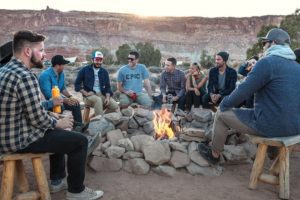It’s no secret that when we step out of our comfort zone to help and lift another person, our outlook improves, our depression and anxiety wane, and our love for others and ourselves increases exponentially. The evidence isn’t just anecdotal, either.
One 2018 study found that engaging in service activities geared toward helping others boosted a participant’s overall mental health by more than 8 percent and decreased their depression by more than 4 percent. Other research shows that volunteering isn’t just effective at boosting your mood in the moment, but that it also contributes to a more permanent change in the way you feel about yourself and about life.

(StockSnap / pixabay)
Maybe this is why the final step in the 12-Step plan for addiction recovery calls on us to serve others. The wording may be unique to each program, but the message is the same:
Having had a spiritual awakening as a result of the Atonement of Jesus Christ, share this message with others and practice these principles in all you do.
“As a faith-based drug rehab facility, we utilize the universally-accepted 12 step principles in combination with gospel principles from the Church of Jesus Christ of Latter-day Saints,” said Preston Dixon, COO, and a former substance abuser now in recovery. “Step 12 is key to our recovery,” he added. “Only through service and by sharing the faith and hope we have gained through hard-won experience can we continue to move forward.”
There are many ways to serve and give back, both in and outside the Substance Use Disorder (SUD) community. One of the biggest ways is to become a sponsor yourself. Being a sponsor means that you partner with a new member and provide them with guidance, advice, and ongoing support as they navigate their way through the 12 steps. You will also encourage them to attend meetings and be there for constant accountability.
Sponsorship benefits you, too, in that it helps reinforce the progress you have already made in your recovery. Other opportunities to serve include:
- Setting up meetings at prisons, hospitals, and addiction treatment centers.
- Hosting seminars, workshops, and podcasts.
- Holding an office within your group, like treasurer or secretary.
- Simple things like giving rides, folding chairs, cleaning up after the meeting, and bringing donuts.
In addition, there are bound to be chances for you to help out within your substance abuse rehab organization or alumni group. For instance, at Renaissance, most of our staff and volunteers are recovering from some form of substance abuse. “They’re here because they want to give back. It’s not just a job for them,” Dixon said. Ranch alumni, known as the Band of Brothers, are everyday volunteers in that they often meet to lift and support one another in recovery.
“Step 12 to me is being in a place where I am able to reach out to those who are struggling and to then let them know that they are not alone. Because there was a point where I felt totally alone,” Erik, who now serves as a 12-Step meeting facilitator, explained in a Renaissance Ranch-sponsored video series illustrating the 12 steps.
Maybe you want to enlist your family and friends in your service activities, but they would like to expand their volunteering beyond the recovery community. Good news – there’s a whole universe of volunteering opportunities out there. Here are a few of our favorites:
1. JustServe
This site helps you connect with local organizations for service projects and opportunities. A neat aspect of this site is that it allows you to view photos and write-ups from past volunteer activities.
2. VolunteerMatch
One of the largest databases for matching non-profit organizations with volunteers, VolunteerMatch has paired more than 15 million volunteers worldwide. Just type in your location, and the site will match you with loads of service opportunities, from helping seniors to conducting mock job interviews for the unemployed.
3. AllForGood (Engage)
Currently transitioning to its new name, Engage, AllForGood is a Points of Light organization dedicated to increasing volunteerism all over the nation. The site has three main sections: Search, Connect, and Create. Search is for individuals to find volunteer opportunities. Connect is for organizations to register with AllForGood. And Create for you to develop your own project and invite others to volunteer.
4. Catchafire
Matching professionals willing to do pro-bono work with non-profit organizations that need their skills is what Catchafire is all about. If you’re a small 501(c)(3), you likely won’t have a huge budget. Accessing a program that puts you in touch with experts willing to donate their time and experience is priceless.
Giving of our time, talents, and means is an investment that pays off handsomely with increased connection, compassion, patience, and love. But even if it didn’t, it still would be the right thing to do.
